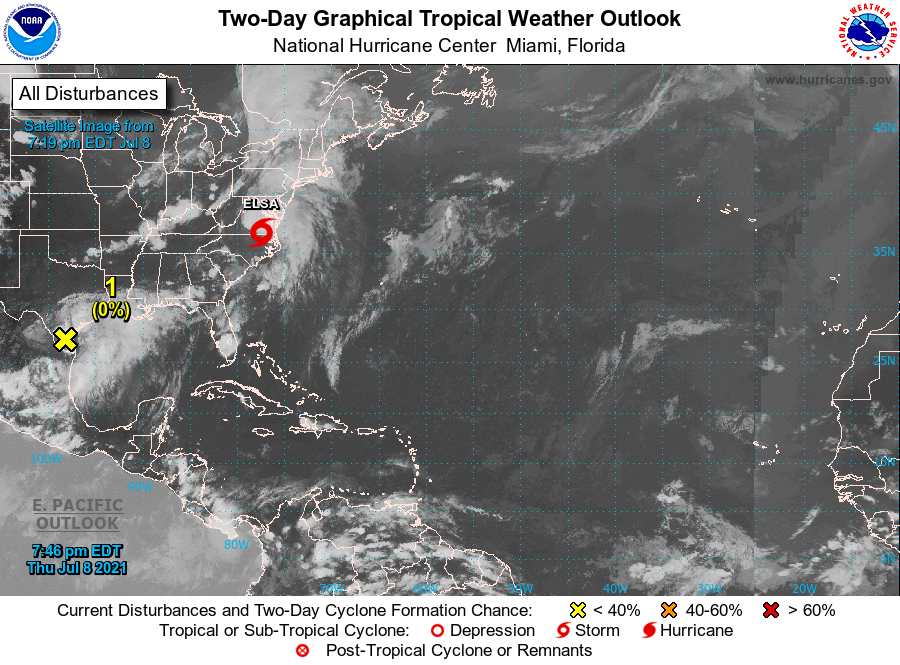My prayers are with all the families, friends and businesses in all areas!
🌀🌀🌀🌀🌀🌀🌀🌀🌀🌀🌀🌀🌀🌀🌀🌀🌀🌀🌀🌀🌀🌀🌀🌀🌀🌀🌀🌀🌀🌀🌀🌀🌀🌀🌀🌀
Tropical Storm Elsa over Virginia now and affecting North Carolina coast and will move along the mid-Atlantic coast later this evening. These winds will spread northward in the warning area over the northeastern states by Friday. Be ready for additional storm surge, high winds, power outages and possible tornadoes. These storms are unpredictable before and after they become extra-tropical (estimated time is tomorrow afternoon) and even though it is not autumn yet, move fast once engulfed into the jet stream’s path. Check out for your local listings here: Nationwide Station Listing Using Broadcast Frequencies. I will keep you posted and informed at the beginning stage of any future activity, when it forms. A collage photo of Elsa on .GIF to follow as soon as it is complete…
Visit: The NOAA NWS National Hurricane Center’s Facebook page for more info. More technical information as provided by cdema.org – Tropical Weather Systems.
The current tropical activity report directly from the NOAA NWS National Hurricane Center:
Atlantic Tropical Report: The Atlantic season for the year 2021 is due to be a busier than normal year, and is off to a heavier than normal year so far. Tropical Storm Elsa has trekked all the way south of most of the Caribbean Islands, across the Florida Keys, the western Florida Gulf Shore, the Panhandle, over Georgia, South Carolina, North Carolina, now Virginia. . . poised to go over the Atlantic states and into the Northeastern Seaboard to south of Greenland by Sunday. A busy week in a wrap, .GIF video to follow! 2 areas of interest near Louisiana and Texas that need to be watched.
🌀🌀🌀🌀🌀🌀🌀🌀🌀🌀🌀🌀🌀🌀🌀🌀🌀🌀🌀🌀🌀🌀🌀🌀🌀🌀🌀🌀🌀🌀🌀🌀🌀🌀🌀🌀
Source: NOAA‘s Article – NOAA predicts another active Atlantic hurricane season | National Oceanic and Atmospheric Administration
🌀🌀🌀🌀🌀🌀🌀🌀🌀🌀🌀🌀🌀🌀🌀🌀🌀🌀🌀🌀🌀🌀🌀🌀🌀🌀🌀🌀🌀🌀🌀🌀🌀🌀🌀🌀
Tips: Preparedness Before, During & After Tropical Weather:
Re-posted article from: 6/22/21: Hurricane & Tropical Safety Starts With Preparedness
Here are tips before the storm, a lot of these should generally be maintained before a hurricane watch is issued, months before a prediction is made:
PREPARATION BEFORE A HURRICANE:
- Strap down the roof. Using hurricane straps/clips to fastening your home’s roof to the frame of the house, thus reducing any roof damage.
- Put head plus foot bolts on all entry doors.
- Buy or make window covers and storm shutters. Board up any remaining windows. Make sure all glass is covered no matter how small to reduce debris.
- Take any antennae and satellite equipment down.
- Caulk around the doors and windows.
- Secure and protect all attached structures. Make sure all patio furniture, grills are put away or get it into your house. Turn off propane and try to cover them if possible.
- Test the sump pumps and drains, and make sure the back-flow flap valves are operating to assure that water does not back up from the drain pipe.
- Turn off ALL utilities at the shut-off valves, and trip the electric main. Pull out all the unnecessary plugs at every receptacle in case of lightning strikes after possible submersion. Do not unplug the refrigerator and/or freezers. Make sure that you have battery operated security as it is not safe to leave AC on during a storm.
- Take before photos to have handy for your information and insurance purposes. They may be necessary to assist your later damages from the storm.
The instance that you hear, several days before onslaught, put off Xbox and all hobbies and get adequate sleep, because once you are going to make a decision and prepare if the hurricane looks like it is going to hit, you are going to need this sleep very badly. DO NOT think for a minute that you can stay and ride out the storm!! Reporters dispatched out into the storm are trained individuals who undergo years of training and underlying experiences, so don’t even think that going out on a whim to stay and see the hurricane is a viable option. When the authorities state that it is unsafe to stay, get ready right away! Do NOT wait until it is too late. Procrastination is your worst enemy, as a bad rush hour is a baby compared to trying to get out late in a hurricane. This is why a lot of times all lanes of highways go the same way–OUT!
- When authorities say to evacuate, DO NOT argue, and do so immediately.
- Make sure you bring proper ID, you will need it to get back when the storm has passed.
- Leave and mobile homes and to go to a nearby shelter.
- If your home is not on high ground or in a flood plain, go to a shelter.
Make sure you do not forget anything at home, because you will not be able to return to home one you leave! The authorities WILL NOT allow you to go back once you make your move for any reason, as they do not have time to deal with security issues and are trained to make sure everyone is getting out. If you wait too long and cannot evacuate, if you have an emergency, a lot of times there may be no assistance for you in an emergency. Phone lines are down even in this computer age, and emergency individuals are swarmed with work, and a lot of people already evacuated. Here are some survival tips:+
DURING A HURRICANE:
- Always stay indoors during a hurricane, and do not venture outside because strong winds will blow things around. The force of a flying object can be deadly or devastating.
- Make sure you know low-lying and flood prone areas, and STAY AWAY. Once water covers, you will not know how low they really are. Do not walk on the flooded areas, as manhole covers wash away, and the chance of falling into a crevice is very dangerous.
- Stay informed by monitoring the storm by radio, and if power is still an option, plug in the TV, and/or internet. A battery operated NOAA.com weather radio is most helpful.
- Avoid the phone, except for a serious emergency.
Stay alert for extended rainfall and all subsequent flooding after the hurricane has passed and tropical storm has moved out of the area. If you evacuated, return only when the officials approve say it is safe. Drive only if necessary and avoid flooded roads and washed out areas. Have ID ready as checkpoints only allow officials, media, cleared parties and people with proper credentials to pass for safety and security.
Here are After the Storm tips:
AFTER A HURRICANE:
Access any and all damages carefully and pay attention to safety, including embedded glass and shrapnel. Have a first aid kit handy.
- Call insurance and only follow the following tips after proper accessing has been done, and don’t forget to take photos first before you fix damages. keep all receipts for supplies, fixing–for insurance or to claim a loss.
- Access the possibility and turn on utilities ONLY if possible, plug in at every receptacle in case of lightning strikes after possible submersion. Make sure that you have battery operated security as it is not safe to leave AC on during a storm.
- Access stability and remove the straps on the roof. Remove hurricane straps/clips to fastening your home’s roof to the frame of the house, thus reducing any roof damage.
- Remove any head/foot bolts on entry doors.
- Remove or higher window covers and storm shutters. Carefully take all board-up and covering down/off.
- Re-install antennae and satellite equipment.
- Take down the strapping from secured attached structures. Re-position all patio furniture, grills, etc. Turn on propane and hook up utilities if possible.
- Check the sump pumps and drains, and make sure they are operating properly to assure that they are ready for subsequent storms.
- It may take several weeks to dispose of refuse, make sure if any waste is hazardous to dispose of properly.
- Fix the decor to return everything to it’s normal state.
The good news of a hurricane, is that they are the most predictable storm on the planet. Except in the late hurricane season of late October and November hurricanes usually move at predictable speeds, and are seen days ahead of time. The problem is that in true reality, if you know that you are in a hurricane zone, you really should play it smart and be prepared with plenty of supplies that are put away in a close storage area, so that the only thing you need to do to prepare for an oncoming hurricane is boarding up and getting out.
A hurricane is a nasty fact of life, but truly is necessary for the world to exist as it does. Hurricanes are mother nature’s control and thermostat to ensure that the oceans do not overheat. The hurricane sheds heat off the ocean surface and casts the heat into outer space really fast. They are true heat vacuums. The cores of heat shed from hurricanes make the ceilings of heat from 5 times to sometimes fifty times higher in altitude. It is the only time heat ever goes this high up. The price? The waters of the tropical oceans pay a high price in lost ocean wildlife and damage to underwater vegetation including the coral reef if the oceans are too warm. Hurricanes also pull the continental weather down further south in this hemisphere to ensure that the polar weather doesn’t get so intense in the tundra areas, so that vegetation can exist. Hurricanes absolutely need to exist if we want to live on earth. They are not going away, and we need to be prepared, and be safe.
FIND YOUR LOCAL NOAA.com WEATHER RADIO STATION:
FIND YOUR LOCAL NATIONAL WEATHER SERVICE FORESCAST:

Courtesy of @NWSNHC on Facebook







I pray that everyone is safe and that Elsa makes her way on through very soon. I’m grateful that you share tips on preparedness and important information!